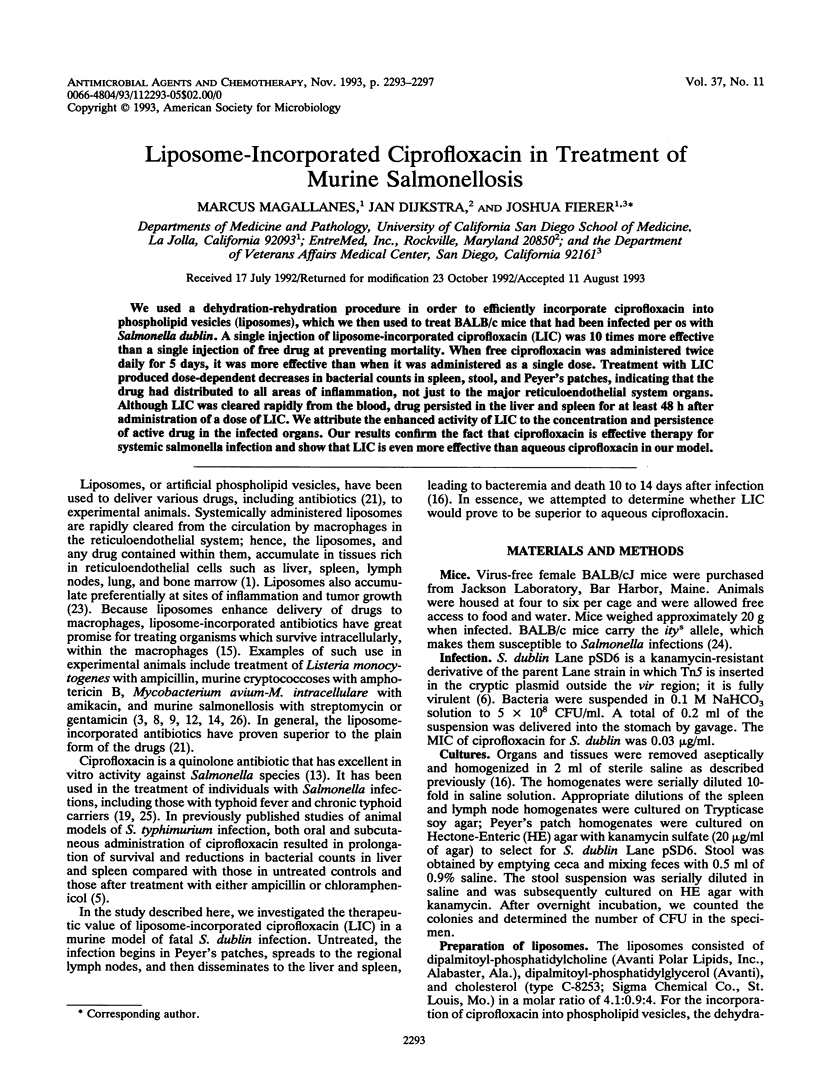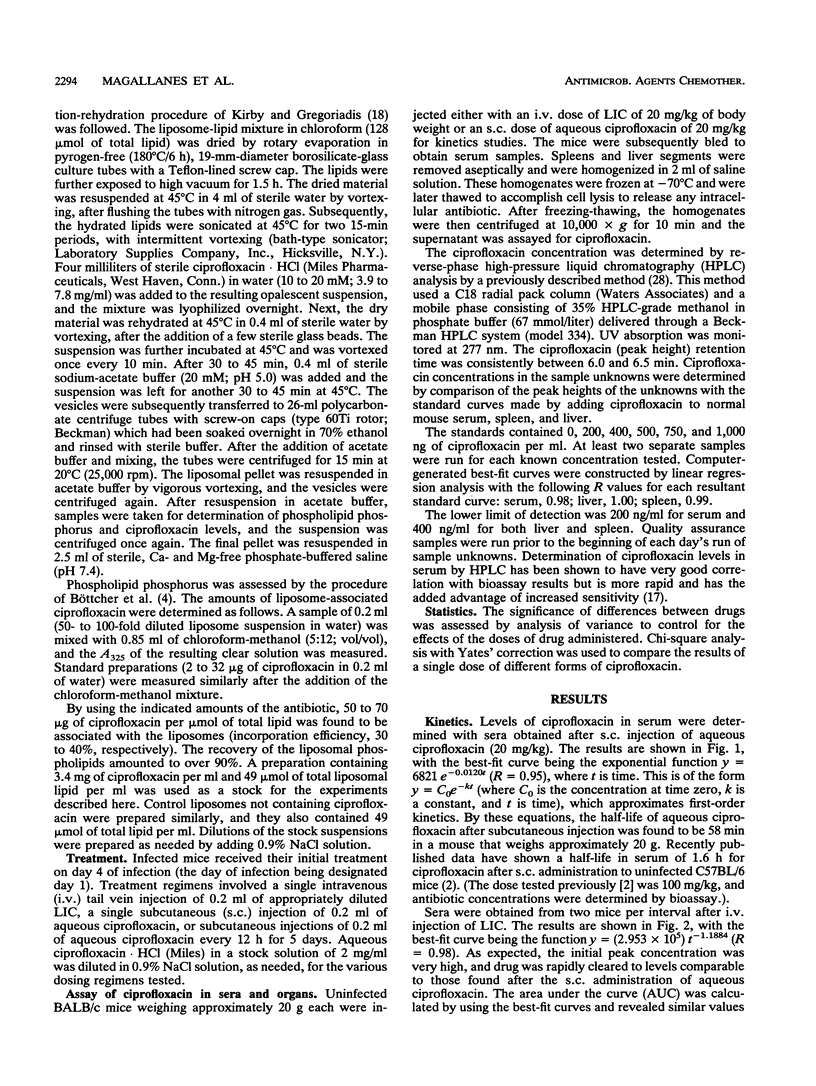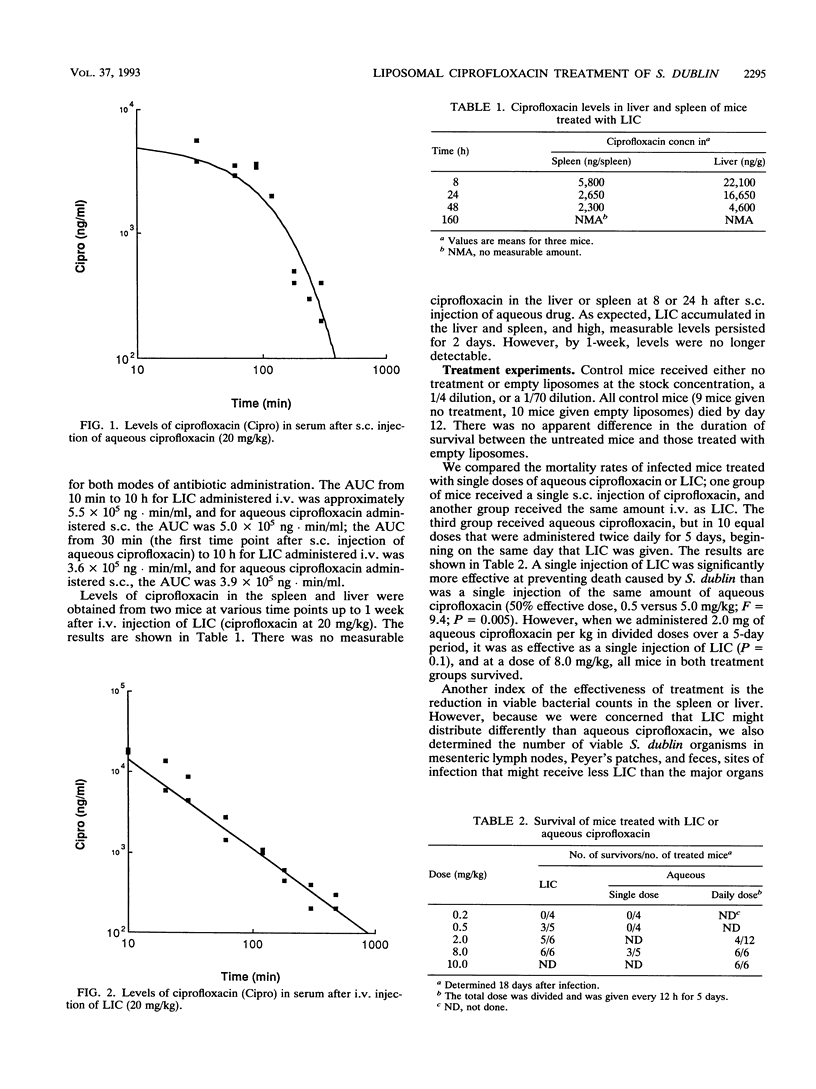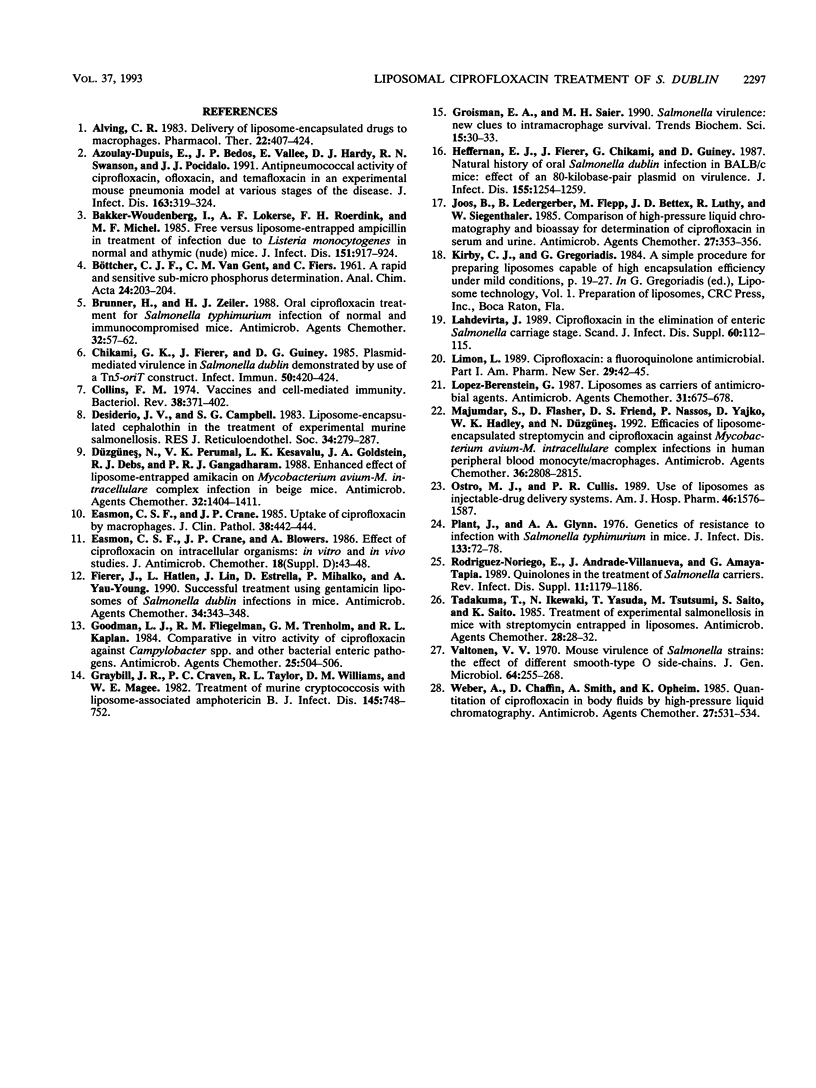Abstract
We used a dehydration-rehydration procedure in order to efficiently incorporate ciprofloxacin into phospholipid vesicles (liposomes), which we then used to treat BALB/c mice that had been infected per os with Salmonella dublin. A single injection of liposome-incorporated ciprofloxacin (LIC) was 10 times more effective than a single injection of free drug at preventing mortality. When free ciprofloxacin was administered twice daily for 5 days, it was more effective than when it was administered as a single dose. Treatment with LIC produced dose-dependent decreases in bacterial counts in spleen, stool, and Peyer's patches, indicating that the drug had distributed to all areas of inflammation, not just to the major reticuloendothelial system organs. Although LIC was cleared rapidly from the blood, drug persisted in the liver and spleen for at least 48 h after administration of a dose of LIC. We attribute the enhanced activity of LIC to the concentration and persistence of active drug in the infected organs. Our results confirm the fact that ciprofloxacin is effective therapy for systemic salmonella infection and show that LIC is even more effective than aqueous ciprofloxacin in our model.
Full text
PDF




Selected References
These references are in PubMed. This may not be the complete list of references from this article.
- Alving C. R. Delivery of liposome-encapsulated drugs to macrophages. Pharmacol Ther. 1983;22(3):407–424. doi: 10.1016/0163-7258(83)90010-4. [DOI] [PubMed] [Google Scholar]
- Azoulay-Dupuis E., Bedos J. P., Vallée E., Hardy D. J., Swanson R. N., Pocidalo J. J. Antipneumococcal activity of ciprofloxacin, ofloxacin, and temafloxacin in an experimental mouse pneumonia model at various stages of the disease. J Infect Dis. 1991 Feb;163(2):319–324. doi: 10.1093/infdis/163.2.319. [DOI] [PubMed] [Google Scholar]
- Bakker-Woudenberg I. A., Lokerse A. F., Roerdink F. H., Regts D., Michel M. F. Free versus liposome-entrapped ampicillin in treatment of infection due to Listeria monocytogenes in normal and athymic (nude) mice. J Infect Dis. 1985 May;151(5):917–924. doi: 10.1093/infdis/151.5.917. [DOI] [PubMed] [Google Scholar]
- Brunner H., Zeiler H. J. Oral ciprofloxacin treatment for Salmonella typhimurium infection of normal and immunocompromised mice. Antimicrob Agents Chemother. 1988 Jan;32(1):57–62. doi: 10.1128/aac.32.1.57. [DOI] [PMC free article] [PubMed] [Google Scholar]
- Chikami G. K., Fierer J., Guiney D. G. Plasmid-mediated virulence in Salmonella dublin demonstrated by use of a Tn5-oriT construct. Infect Immun. 1985 Nov;50(2):420–424. doi: 10.1128/iai.50.2.420-424.1985. [DOI] [PMC free article] [PubMed] [Google Scholar]
- Collins F. M. Vaccines and cell-mediated immunity. Bacteriol Rev. 1974 Dec;38(4):371–402. doi: 10.1128/br.38.4.371-402.1974. [DOI] [PMC free article] [PubMed] [Google Scholar]
- Desiderio J. V., Campbell S. G. Liposome-encapsulated cephalothin in the treatment of experimental murine salmonellosis. J Reticuloendothel Soc. 1983 Oct;34(4):279–287. [PubMed] [Google Scholar]
- Düzgüneş N., Perumal V. K., Kesavalu L., Goldstein J. A., Debs R. J., Gangadharam P. R. Enhanced effect of liposome-encapsulated amikacin on Mycobacterium avium-M. intracellulare complex infection in beige mice. Antimicrob Agents Chemother. 1988 Sep;32(9):1404–1411. doi: 10.1128/aac.32.9.1404. [DOI] [PMC free article] [PubMed] [Google Scholar]
- Easmon C. S., Crane J. P., Blowers A. Effect of ciprofloxacin on intracellular organisms: in-vitro and in-vivo studies. J Antimicrob Chemother. 1986 Nov;18 (Suppl 500):43–48. doi: 10.1093/jac/18.supplement_d.43. [DOI] [PubMed] [Google Scholar]
- Easmon C. S., Crane J. P. Uptake of ciprofloxacin by macrophages. J Clin Pathol. 1985 Apr;38(4):442–444. doi: 10.1136/jcp.38.4.442. [DOI] [PMC free article] [PubMed] [Google Scholar]
- Fierer J., Hatlen L., Lin J. P., Estrella D., Mihalko P., Yau-Young A. Successful treatment using gentamicin liposomes of Salmonella dublin infections in mice. Antimicrob Agents Chemother. 1990 Feb;34(2):343–348. doi: 10.1128/aac.34.2.343. [DOI] [PMC free article] [PubMed] [Google Scholar]
- Goodman L. J., Fliegelman R. M., Trenholme G. M., Kaplan R. L. Comparative in vitro activity of ciprofloxacin against Campylobacter spp. and other bacterial enteric pathogens. Antimicrob Agents Chemother. 1984 Apr;25(4):504–506. doi: 10.1128/aac.25.4.504. [DOI] [PMC free article] [PubMed] [Google Scholar]
- Graybill J. R., Craven P. C., Taylor R. L., Williams D. M., Magee W. E. Treatment of murine cryptococcosis with liposome-associated amphotericin B. J Infect Dis. 1982 May;145(5):748–752. doi: 10.1093/infdis/145.2.748. [DOI] [PubMed] [Google Scholar]
- Groisman E. A., Saier M. H., Jr Salmonella virulence: new clues to intramacrophage survival. Trends Biochem Sci. 1990 Jan;15(1):30–33. doi: 10.1016/0968-0004(90)90128-x. [DOI] [PubMed] [Google Scholar]
- Heffernan E. J., Fierer J., Chikami G., Guiney D. Natural history of oral Salmonella dublin infection in BALB/c mice: effect of an 80-kilobase-pair plasmid on virulence. J Infect Dis. 1987 Jun;155(6):1254–1259. doi: 10.1093/infdis/155.6.1254. [DOI] [PubMed] [Google Scholar]
- Joos B., Ledergerber B., Flepp M., Bettex J. D., Lüthy R., Siegenthaler W. Comparison of high-pressure liquid chromatography and bioassay for determination of ciprofloxacin in serum and urine. Antimicrob Agents Chemother. 1985 Mar;27(3):353–356. doi: 10.1128/aac.27.3.353. [DOI] [PMC free article] [PubMed] [Google Scholar]
- Limon L. Ciprofloxacin: a fluoroquinolone antimicrobial. Part 1. Am Pharm. 1989 Jun;NS29(6):42–45. doi: 10.1016/s0160-3450(15)31763-3. [DOI] [PubMed] [Google Scholar]
- Lopez-Berestein G. Liposomes as carriers of antimicrobial agents. Antimicrob Agents Chemother. 1987 May;31(5):675–678. doi: 10.1128/aac.31.5.675. [DOI] [PMC free article] [PubMed] [Google Scholar]
- Lähdevirta J. Ciprofloxacin in the elimination of enteric Salmonella carriage stage. Scand J Infect Dis Suppl. 1989;60:112–115. [PubMed] [Google Scholar]
- Majumdar S., Flasher D., Friend D. S., Nassos P., Yajko D., Hadley W. K., Düzgüneş N. Efficacies of liposome-encapsulated streptomycin and ciprofloxacin against Mycobacterium avium-M. intracellulare complex infections in human peripheral blood monocyte/macrophages. Antimicrob Agents Chemother. 1992 Dec;36(12):2808–2815. doi: 10.1128/aac.36.12.2808. [DOI] [PMC free article] [PubMed] [Google Scholar]
- Ostro M. J., Cullis P. R. Use of liposomes as injectable-drug delivery systems. Am J Hosp Pharm. 1989 Aug;46(8):1576–1587. [PubMed] [Google Scholar]
- Plant J., Glynn A. A. Genetics of resistance to infection with Salmonella typhimurium in mice. J Infect Dis. 1976 Jan;133(1):72–78. doi: 10.1093/infdis/133.1.72. [DOI] [PubMed] [Google Scholar]
- Tadakuma T., Ikewaki N., Yasuda T., Tsutsumi M., Saito S., Saito K. Treatment of experimental salmonellosis in mice with streptomycin entrapped in liposomes. Antimicrob Agents Chemother. 1985 Jul;28(1):28–32. doi: 10.1128/aac.28.1.28. [DOI] [PMC free article] [PubMed] [Google Scholar]
- Valtonen V. V. Mouse virulence of Salmonella strains: the effect of different smooth-type O side-chains. J Gen Microbiol. 1970 Dec;64(3):255–268. doi: 10.1099/00221287-64-3-255. [DOI] [PubMed] [Google Scholar]
- Weber A., Chaffin D., Smith A., Opheim K. E. Quantitation of ciprofloxacin in body fluids by high-pressure liquid chromatography. Antimicrob Agents Chemother. 1985 Apr;27(4):531–534. doi: 10.1128/aac.27.4.531. [DOI] [PMC free article] [PubMed] [Google Scholar]


